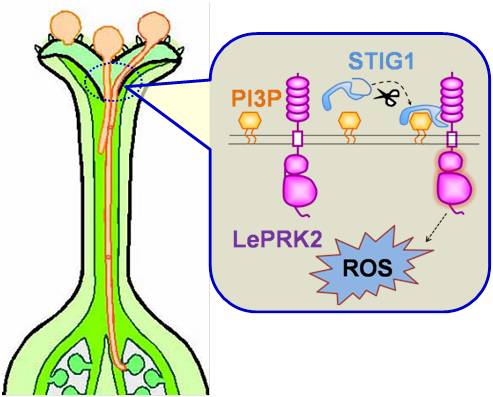植生态所在Plant Cell揭示STIG1促进雌蕊中花粉管生长机制
中科院上海生科院植物生理生态研究所唐威华研究组发现STIG1作为雌蕊柱头分泌的信号小肽,能够结合位于花粉管表面的磷脂酰肌醇3-磷酸(PI3P),进而激活花粉特异受体激酶LePRK2所介导的信号转导,促进雌蕊中花粉管生长。相关文章发表于2014年6月18日的《Plant Cell》杂志上。

花粉管的快速生长对于显花植物的有性生殖至关重要。虽然许多植物的花粉在含有硼酸,钙离子和蔗糖的培养基中也能够萌发和快速生长,但是体外培养所能达到生长速率远远比不上其在雌蕊中的生长速率。花粉特异受体激酶(Pollen receptor kinases, LRR-RLKs)是一类定位于细胞表面的受体激酶,被认为在花粉对外界信号的感知、花粉管本身极性生长的调控等过程中起作用。
该研究组之前从番茄雌蕊柱头组织中鉴定到一个能够与番茄花粉受体激酶LePRK2相互作用的分泌蛋白STIG1。有意思的是,体外培养条件下,外加STIG1能够促进花粉管的生长,但其在体内是否有功能,如何发挥功能还是未知的。
在最新发表的论文中,作者发现STIG1在柱头上会被剪切加工成一个约7 kDa的成熟肽段。当花粉在柱头萌发,成熟的STIG1肽段会富集到花粉管表面发挥作用。STIG1表达量的降低,使得花粉管生长变慢。用STIG1重组蛋白同时处理野生型和LePRK2 antisense的花粉发现,LePRK2 antisense的花粉对STIG1的响应度变弱。并且,研究人员还将STIG1与LePRK2 胞外域相互作用的区段定位到成熟肽段中的四个氨基酸残基上。另外,通过磷脂结合试验,研究人员在STIG1成熟肽段中检测到两个磷脂肌醇结合位点,分别能够结合PI4P和PI3P。
进一步的实验证据表明,STIG1能够结合位于花粉管表面的PI3P。利用能够指示体内氧化还原(Redox)水平变化的rogfp,研究者还发现STIG1能够促进花粉管内氧化还原水平上升,并且这一过程同时依赖于PI3P和LePRK2。
该研究明确了STIG1作为一类新的肽类激素,通过与花粉受体激酶LePRK2的相互作用,能够促进花粉管生长。STIG1能够结合磷脂酰肌醇PI3P也丰富了我们对肽类激素信号转导的认识,对于人们了解PI3P功能提供了新的线索。
该研究得到了国家自然科学基金委、国家科技部的经费支持。
原文摘要:
Wei-Jie Huang, Hai-Kuan Liu, Sheila McCormick and Wei-Hua Tang
The speed of pollen tube growth is a major determinant of reproductive success in flowering plants. Tomato (Solanum lycopersicum) STIGMA-SPECIFIC PROTEIN1 (STIG1), a small Cys-rich protein from the pistil, was previously identified as a binding partner of the pollen receptor kinase LePRK2 andshown to promote pollen tube growth in vitro. However, the in vivo functionof STIG1 and the underlying mechanism of its promotive effect were unknown. Here, we show that a 7-kD processed peptide of STIG1 is abundant in thestigmatic exudate and accumulates at the pollen tube surface, where it can bind LePRK2. Antisense LePRK2 pollen was less responsive than wild-typepollen to exogenous STIG1 in an in vitro pollen germination assay. Silencingof STIG1 reduced both the in vivo pollen tube elongation rate and seed production. Using partial deletion and point mutation analyses, two regions underlying the promotive activity of the STIG1 processed peptide were identified: amino acids 80 to 83, which interact with LePRK2; and amino acids 88 to 115, which bind specifically to phosphatidylinositol 3-phosphate [PI(3)P]. Furthermore, exogenous STIG1 elevated the overall redox potential ofpollen tubes in both PI(3)P-dependent and LePRK2-dependent manners. Our results demonstrate that STIG1 conveys growth-promoting signals acting through the pollen receptor kinase LePRK2, a process that relies on theexternal phosphoinositide PI(3)P.
作者:植生态所

